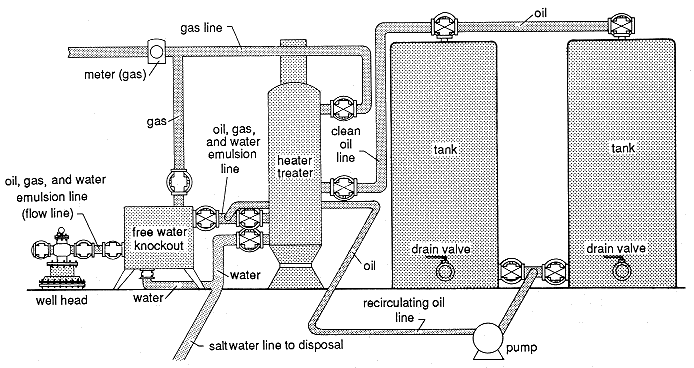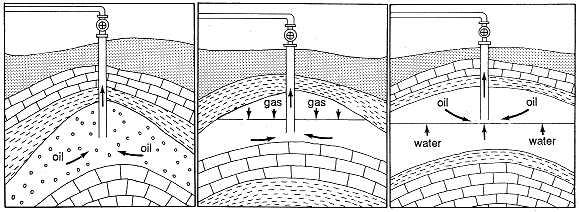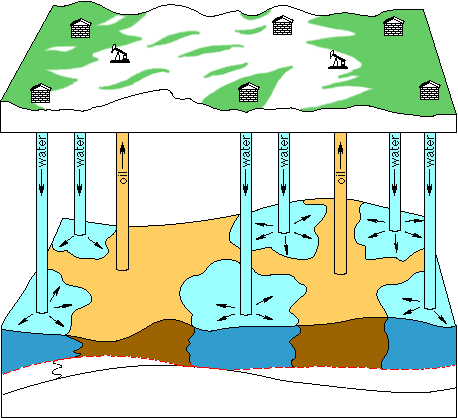
Petroleum: a primer for Kansas, Page 13 of 15
Prev Page--Drilling the well ||
Next Page--Conclusions
Figure 28--Surface equipment. Oil, gas, and water, as an emulsion, enter the free water knockout. Some gas and water are separated from the emulsion at this point. The remaining emulsion enters the heater treater where it is heated and the emulsion is separated into oil, gas, and water. The water is drained off and sent to disposal. The gas passes into the gas line, where it is metered and sent to market. The oil passes into the tanks. From there, it may be loaded into trucks from the drain valves or conected to a pipeline. The pump is used for recirculating oil that may have impurities in it back through the treater and into the tanks.

The quantities of oil, gas, and water that are produced from the well are measured and recorded. Oil production may be measured with special metering equipment if it is produced into a consolidated tank battery or it may be gauged by measuring the height of the oil level in the storage tanks. When a tank full of oil is delivered to a refiner or crude-oil purchaser by pipeline, truck, or tank car, the oil is measured by gauging the height of oil in the tank. At that time the oil will be tested to determine its gravity (density) because the price paid for crude oil varies with its gravity. The temperature of the oil is determined as well as its content of basic sediment and water. This is done so that the quantity of oil in the tank can be converted into net barrels of oil delivered.
The quantity of gas produced is measured by a meter before it enters the pipeline to the processing facility. The quantity of water produced may be measured by a meter at the heater treater before it enters the saltwater-handling facility or the flow line to the disposal well. Water production is also determined by periodically testing the oil, gas, and water emulsion before it is separated to determine the percentage of water or "water cut" in the produced fluid.
Figure 29--Reservoir-drive mechanisms. Dissolved gas drive is the result of the expansion of gas that is dissolved in the oil. Gas-cap drive is the result of the expansion of gas which is contained in the reservoir above the oil. Water drive is the result of the upward pressure of water as it expands and moves into the regions of lowered pressure as oil is produced.

Reservoir energy has been replenished in some cases by the injection of gas or fluids into the reservoir. This practice is known as pressure maintenance or secondary recovery. The production of oil and gas without pressure maintenance is known as primary recovery.
Pressure maintenance is not without its problems, however. When gas or liquids are injected into a producing formation or interval, oil and gas are pushed across property lines. A means must be provided to protect the rights of all persons who have royalty or production interests. This is done by unitizing the reservoir. In order to do this, a detailed engineering study of the reservoir or oil pool is conducted to determine the amount of oil that is produced that should be allocated to the various operators and mineral-rights owners. In Kansas, a plan of unitization must be developed which includes specific provisions. The plan must be approved or ratified by the lessees or operators and by the persons owning interests in the production such as royalties, overriding royalties, and production payments. The plan of unitization must also be approved by the Kansas Corporation Commission, which is the state regulatory body governing oil and gas matters.
Pressure maintenance, or secondary recovery, is accomplished by injecting air or water into the producing formation through wells which are located at strategic positions. The injected air or water results in an increase in pressure within the producing formation relative to the pressure in the well bore of the producing wells (fig. 30). Secondary maintenance will not restore reservoir energy to its original condition, but it can and does result in a significant increase in the production of oil and gas from a reservoir. Even after the application of pressure maintenance, a considerable amount of oil may be left in the reservoir. This is residual oil that cannot be moved into the producing wells by pressure alone. Methods are being developed that will enable much of this residual oil to be flushed from reservoir rock and into the producing wells. This is known as tertiary recovery.
Figure 30--Water flood is one means of secondary recovery. Water is injected into the producing horizon to increase reservoir pressure and push the oil toward the producing wells. Note that the rocks below the dashed line are less permeable than those above.

Prev Page--Drilling the well || Next Page--Conclusions